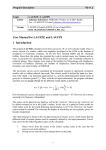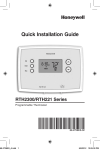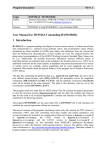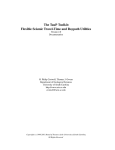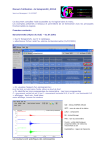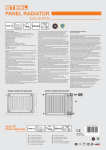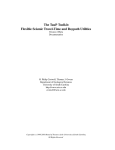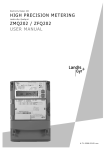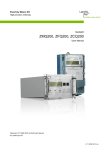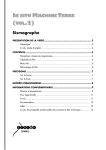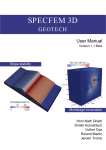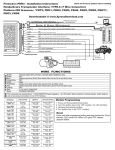Download User Manual for LAUFZE and LAUFPS 1 Introduction
Transcript
Program Description PD 11.2 Topic LAUFZE / LAUFPS Author Johannes Schweitzer, NORSAR, P.O.Box 53, N-2027 Kjeller Fax: +47 63818719, E-mail: [email protected] Version LAUFZE 6.0 and LAUFPS 3.0 (as of October 2002) User Manual for LAUFZE and LAUFPS 1 Introduction The program LAUFZE calculates travel-time curves for a P- or an S-velocity model. This is a new version of a routine, which was originally developed in the 1970s at the Institute of Geophysics in Karlsruhe, Germany, by the late Prof. Gerhard Müller and Dr. Christoph Gelbke. Since then, the author has extended the code to include many new features and options, in particular for calculating different types of teleseismic phases. The code has been developed at the Institute for Meteorology and Geophysics, University of Frankfurt, Germany, the Institute of Geophysics, Ruhr-University Bochum, Germany, and, most recently, in this new (English) version at NORSAR. The travel-time curves can be calculated for horizontally layered or spherically symmetric models with or without reduced time scale. The velocity model is defined by input as a function of the depth z, the dominant signal period Tsig, and the depth-dependent quality factor Q given for a reference period Tref. With this input the program calculates the group velocity as defined by: u ( z , T , Q) = v( z ) ⋅ (1 + Tref 1 ⋅ (ln( ) + 1)) π ⋅ Q( z ) Tsig If no Q-structure is given, the program uses as default value Q(z) = 106. However, Q is always assumed to be frequency independent. The source can be placed in any depth but the ‘receivers’ are assumed to be at the Earth’s surface. In the case of a spherical Earth model the Earth radius used for the Earth-flattening transformation is 6371 km. However, the Earth’s center cannot be reached! The velocities for depths, at which they are not explicitly given, are linearly interpolated. The whole program is based on the ray approximation of seismic waves, which means that the different kinds of seismic phases must be separately defined by the input parameters. Traveltime curves for the following phase types can be calculated: I II III Direct waves from the source to the Earth’s surface (only in the case that the source is not at the surface). Diving waves from the source radiated down in the Earth. Reflections from any layer below the source, back to the Earth’s surface (e.g., PcP, ScP, PmP). 1 Program Description PD 11.2 IV Reflections of diving waves at any layer back down into the Earth (e.g., PP, SS, PKKP, SKKS). V Multiples between any two layers (e.g., PPmP, a diving P wave from source to the Earth’s surface, reflected from there back into the Earth, and finally reflected at the Mohorovičić (Moho) discontinuity back to the surface). VI For the phases III – V, any number of multiple reflections can be calculated (e.g., P3, P5KP, SmS3). VII If the source is not at the surface, for all phases of II – VI the corresponding surface reflections can be calculated (e.g., pP, sScS, pP3KP). VIII The multiple reflection(s) as defined under V will automatically be calculated for all above defined phases. That means, e.g., not only for the direct P phase a Moho reverberation PPmP will be calculated but also e.g., for pPKP we will get a pPKPPmP phase. IX For the direct to the surface radiated wave (see I) reflections can be calculated from any layer between source and the Earth’s surface down back into the Earth (e.g., p450P, or smS, but also pP). All parameters for steering the program must be given in a formatted ASCII file. The program asks for the name of the input file. All results of the program are written in a ASCII file called laufze-out. This file can then easily be edited and the listed travel-time curves can then be plotted with any plotting routine or used as ASCII input for other programs. LAUFPS is a program like LAUFZE but it calculates travel times not only for one model (P or S) but also for both models together in one step, including converted phases. The newest versions of the programs (including source code, this manual, data files containing examples for input and output files) are located in two compressed tar-files; either in laufze.version.tar.Z or in laufze.version.tar.gz for free download from NORSAR’s anonymous ftp-address ftp.norsar.no under the directory /pub/outgoing/johannes/lauf. If using your web-browser, the address is: ftp://ftp.norsar.no/pub/outgoing/johannes/lauf. Questions related to program updates and maintenance should be directed to the author. 2 Getting Started This section describes how the example for LAUFZE can be started and executed. The simplest way to use the program for own travel-time calculations is to use the following examples and to modify the input data and parameters for your need. The meaning and format of the input is described in the following sections. Installation of LAUFZE: 1) Make a sub-directory for LAUFZE, copy the compressed tar-file containing the laufzesoftware package from the ftp.norsar.no site, decompress it, and run: tar -xvf laufze.version.tar 2 Program Description PD 11.2 You will then have a directory containing the following files and subdirectories: bin/ bin_l/ examples/ man/ README src/ The file README contains a complete list of all files included in the laufze-software package and a short explanation of these files. 2) If needed, recompile the software in the src/ subdirectory by running: make –f Makefile.laufze and/or make -f Makefile.laufps The software was tested under UNIX as well under LINUX and should therefore run on both platforms without any compatibility problems. In the case of a LINUX system please use the corresponding Makefiles with the extension _linux. 3) Executing LAUFZE: Change to the subdirectory examples/. Here you will find an example for an input file. LAUFZE runs with one input file. To check your installation, try the following: run: ../bin/laufze The program needs one input file in ASCII format. You will be asked for the name of the input file and you here answer with laufze-in. This file contains all parameters to steer the travel-time calculations and the layered velocity model. All results of the program are written in a file called laufze-out. The output file you get should be identical to the file laufze-out.test distributed with the laufze-software package. Contents and structure of these files will be explained in the following sections. The program LAUFPS uses the same input file format as LAUFZE but it needs two files, one containing the P-velocity model and ray definitions for P phases and one file containing the S-velocity model and ray definitions for S phases. After starting the program with ../bin/laufps you will be asked for names of the files containing the P- and S-velocity models and the file to steer the behaviour of all P-to-SV and/or SV-to-P conversions (e.g., laufp-dat, laufs-dat, and laufps-in). If you use the files as delivered with the laufze-software package, the LAUFPS output file laufps-out should be identical to the file laufps-out.test. 3 Program Description PD 11.2 3 The File laufze-in The file laufze-in must contain the velocity model for P (or S) waves and all information about the seismic phases for which travel times shall be calculated. The program asks for the name of the file containing this information in the format below described. The user can of course use any file name. ------------- example for a laufze-in file --------------------------------------------For a source 0.000 0.000 0.0 33.0 33.0 100. 200. 300. 413. 600. 800. 1000. 1200. 1400. 1600. 1800. 2000. 2200. 2400. 2600. 2800. 2898. 2898. 3000. 3200. 3400. 3600. 3800. 4000. 4200. 4400. 4600. 4800. 4982. 5121. 5121. 5700. 1 1 1 1 21 21 1 in 100 km, Jeffreys-Bullen Model 180.000 0.00 0 0 0.000 0 0 0 6.11 STRU 0.000 ! for pP 6.11 7.76 7.95 SOUR 8.26 8.58 8.97 10.25 11.00 11.42 11.71 11.99 12.26 12.53 12.79 13.03 13.27 13.50 13.64 13.64 REFL ! for PcP 8.10 8.22 8.47 8.76 9.04 9.28 9.51 9.70 9.88 10.06 10.25 10.44 10.44 REFL ! for PKiKP 11.16 11.26 ! blank line, more layers 20 1 ! for PP 2 ! for P3 1 ! for PKKP 2 ! for P3KP ! blank line: no more such mult. phases ! for PcPPcP + PKiKPPKiKP ! blank line: no more such mult. phases ----- end of the example--------------------------------------------------------------- 4 Program Description PD 11.2 The contents of the laufze-in file is as follows: 1. 1 line of maximum 80 characters with any explaining text as TITLE. 2. 1 line in FORMAT (3F10.3,3I5) containing the parameters: RMIN, RMAX, VR, IELAS, NF11. RMIN is the beginning of the distance range from which onset times are calculated. Either measured in [deg] or in [km], see the definition of VR. RMAX as RMIN but the end of the distance range used to print out the travel-time branches. VR is the velocity or slowness to reduce the travel times. If VR > 0, RMIN and RMAX are measured in [km] and VR is a reduction velocity [km/s]. If VR <= 0, RMIN and RMAX are measured in [deg] and VR is a reduction slowness [s/deg]. IELAS if this flag is set to 1, Q(z) is set to 106 in all depths (pure elastic case). NF11 if this flag is set to 1, no direct up-going rays from a source below the surface are calculated. 3. 1 line in FORMAT (2F10.3,3I5) containing the parameters: PER, PEREFF, LA1, LA2, NLA. PER is the dominant signal period Tsig [s]. PERREF is the reference period Tref [s]. If these two period values are set to 0 s, the default value of 1 s is used. LA1 is the number of the upper layer for the described reverberations (see V of the program options in the introduction). LA2 as LA1, now the number of the lower layer. NLA gives the number of reverberations. The multiple travels through the depth range Z(LA1) <= Z(I) < Z(LA2) NLA times more than the regular phase. If LA1 = LA2 or NLA = 0, no reverberations are calculated. 4. Now follows the model. The model is defined by one line for each depth with velocity information. All lines must fit in the FORMAT (2F10.3,A4,6x,F10.3) and contain the parameters Z, V, AZ, QU. The model can contain a maximum of 1000 layers. First order discontinuities for one of the given parameters has to be defined by 2 lines in the same depth Z. Z depth in [km] below the Earth’s surface. The surface has the depth Z(1) = 0. V seismic velocity in the depth Z. 5 Program Description PD 11.2 AZ four characters long key words, with which one can define special actions in this depth: = SOUR means that the source is in this depth of the model. = SURF means that the source is in this depth and that for all (!) phases also the surface reflections are calculated (e.g., pP, sScS, ...). = STRU means that an up-going direct ray is reflected in this depth back down into the Earth (see IX of the program options in the introduction). If STRU is set at the surface, the classical surface reflection is calculated (i.e., only pP or sS but not e.g., pPP or sScS). = REFL means that steep-angle reflections from this depth are calculated (see III of the program options in the introduction). In all other cases AZ must be blank. QU is the quality factor for seismic waves in this depth; if QU = 0. the program sets it by default to QU = 1 000 000. An empty line finishes the model input. 5. 6. 1 line in FORMAT (3I5) with the three parameters IS, IA, IB. IS = 0 the input model is assumed to be flat, i.e., it consists of a set of horizontally flat layers. = 1 the input model is spherical and has to be transformed by the Earth-flattening transformation. IA = I ; only the parts of the travel-time curves, which have their turning points below the I’th layer, are calculated. If IA = 1, all travel-time branches of all phases are calculated. IB gives the number of rays, which will have their turning points between two depth points of the model; IB values of 10 – 20 usually give a good approximation of the travel-time branch. In the following line(s), the reflections of diving rays at any layer back down into the Earth can be defined (see IV of the program options in the introduction). For each (!) such reflection 1 line in FORMAT (2I10) is needed with the parameters IKMG and MULT. If no (further) reflections of this type are to be calculated, one has to give a blank line. IKMG is the number of the layer at which the ray is reflected; e.g., for PP one has to set IKMG = 1. MULT gives the number of reflections at this reflector (e.g., for PP, SS, or PKKP one has to set MULT = 1, for P3, S3, or S3KS one has to use MULT =2). 7. Finally, multiple reflections for the steep-angle reflections as defined with AZ = REFL can be ordered with the following line(s) in FORMAT (I10) containing the parameter MULTR. No (further) multiples of this type have to be indicated by another blank line. 6 Program Description PD 11.2 MULTR gives the number of multiples for each order steep-angle reflection. MULTR = 1 will, for example, result in PmP2 or ScS2 and MULT = 2 will give, e.g., ScS3. 4 The File laufze-out With the above example for a laufze-in file, you will obtain the output-file laufze-out. Please note that the output file has been truncated by numerous lines to reduce the number of pages in this manual. The ASCII listing of the travel times can easily be extracted and the user can plot them with any plotting program after some simple editing work. The original output file has 3117 lines and is included in the laufze-software package. Explanations are included in [ .... ]: ------------------example for a laufze-out file ---------------------------------------Travel times from LAUFZE 6.0 For a source in 100 km, Jeffreys-Bullen Model Distance range RMIN = 0.000 deg RMAX = 180.000 deg Ray parameter to reduce travel times P = 0.000 s/deg The travel times are calculated for a group velocity at a reference period of 1.000 s Model input (depth, velocity) + modified velocity-depth function after application of the Earth-flattening transformation Z 0.000 33.000 33.000 100.000 200.000 300.000 413.000 600.000 800.000 1000.000 1200.000 1400.000 1600.000 1800.000 2000.000 2200.000 2400.000 V(Z) 6.110 6.110 7.760 7.950 8.260 8.580 8.970 10.250 11.000 11.420 11.710 11.990 12.260 12.530 12.790 13.030 13.270 Q(Z) 1000000.0 1000000.0 1000000.0 1000000.0 1000000.0 1000000.0 1000000.0 1000000.0 1000000.0 1000000.0 1000000.0 1000000.0 1000000.0 1000000.0 1000000.0 1000000.0 1000000.0 U(Z,Q,PER) AZ(Z) 6.110 6.110 7.760 7.950 8.260 8.580 8.970 10.250 11.000 11.420 11.710 11.990 12.260 12.530 12.790 13.030 13.270 7 STRU SOUR FLATT EARTH [ Z-FL U-FL] 0.000 33.086 33.086 100.793 203.207 307.293 426.995 630.162 854.873 1087.799 1329.566 1580.871 1842.496 2115.328 2400.367 2698.760 3011.817 6.110 6.142 7.800 8.077 8.528 9.004 9.592 11.316 12.580 13.546 14.427 15.367 16.372 17.464 18.642 19.903 21.290 Program Description 2600.000 2800.000 2898.000 2898.000 3000.000 3200.000 3400.000 3600.000 3800.000 4000.000 4200.000 4400.000 4600.000 4800.000 4982.000 5121.000 5121.000 5700.000 13.500 13.640 13.640 8.100 8.220 8.470 8.760 9.040 9.280 9.510 9.700 9.880 10.060 10.250 10.440 10.440 11.160 11.260 PD 11.2 1000000.0 1000000.0 1000000.0 1000000.0 1000000.0 1000000.0 1000000.0 1000000.0 1000000.0 1000000.0 1000000.0 1000000.0 1000000.0 1000000.0 1000000.0 1000000.0 1000000.0 1000000.0 13.500 13.640 13.640 8.100 8.220 8.470 8.760 9.040 9.280 9.510 9.700 9.880 10.060 10.250 10.440 10.440 11.160 11.260 3341.056 3688.241 REFL 3865.526 3865.526 4055.441 4445.107 4860.167 5304.164 5781.437 6297.381 6858.818 7474.555 8156.231 8919.681 9704.131 REFL 10375.893 10375.893 14339.481 22.808 24.335 25.022 14.859 15.535 17.017 18.785 20.785 22.996 25.554 28.466 31.936 36.190 41.568 47.886 53.211 56.880 106.911 Travel-time branch 1 and all the following ones were calculated, each travel-time branch consists of 20 rays P H A S E : [ If NF11 is set to 1, this wave will not be calculated ] Directly upgoing wave [ DELTA is the distance measured in [km] or in [deg], see input parameter VR, TT is the (eventually reduced) travel time, AIN is the radiation angle at the source, T* is the travel time divided by the mean quality factor TT/Q, ATT is the amplitude attenuation due to T*, i.e., ATT = EXP(-2*PI*fref*T*], and P is the ray parameter measured in [s/deg] ] DELTA 0.000 0.033 0.066 0.099 0.132 0.166 0.200 0.234 0.269 0.305 0.342 0.380 0.419 0.459 0.500 0.543 0.588 0.635 0.685 0.737 TT 13.931 13.940 13.967 14.012 14.075 14.158 14.260 14.381 14.524 14.688 14.874 15.085 15.321 15.584 15.877 16.201 16.559 16.954 17.389 17.870 AIN 180.000 177.722 175.443 173.165 170.886 168.608 166.329 164.051 161.772 159.494 157.215 154.937 152.658 150.380 148.101 145.823 143.544 141.266 138.987 136.709 T* 0.000 0.000 0.000 0.000 0.000 0.000 0.000 0.000 0.000 0.000 0.000 0.000 0.000 0.000 0.000 0.000 0.000 0.000 0.000 0.000 8 ATT 1.000 1.000 1.000 1.000 1.000 1.000 1.000 1.000 1.000 1.000 1.000 1.000 1.000 1.000 1.000 1.000 1.000 1.000 1.000 1.000 P 0.000 0.547 1.094 1.639 2.181 2.719 3.254 3.783 4.306 4.823 5.332 5.832 6.323 6.804 7.275 7.734 8.181 8.614 9.034 9.440 Program Description 0.792 0.850 0.913 0.980 1.053 1.131 1.218 1.313 1.418 1.536 1.670 1.823 2.000 2.207 2.451 2.742 3.091 3.512 4.018 4.621 PD 11.2 18.401 18.988 19.638 20.359 21.162 22.059 23.067 24.204 25.494 26.969 28.667 30.640 32.953 35.688 38.953 42.881 47.631 53.386 60.330 68.624 P H A S E 134.430 132.152 129.873 127.595 125.316 123.038 120.759 118.481 116.203 113.924 111.646 109.367 107.089 104.810 102.532 100.253 97.975 95.696 93.418 91.139 0.000 0.000 0.000 0.000 0.000 0.000 0.000 0.000 0.000 0.000 0.000 0.000 0.000 0.000 0.000 0.000 0.000 0.000 0.000 0.000 1.000 1.000 1.000 1.000 1.000 1.000 1.000 1.000 1.000 1.000 1.000 1.000 1.000 1.000 1.000 1.000 1.000 1.000 1.000 1.000 9.831 10.207 10.566 10.908 11.234 11.541 11.830 12.101 12.353 12.584 12.796 12.988 13.159 13.310 13.439 13.547 13.634 13.699 13.743 13.765 : Diving wave [ DELTA is the distance measured in [km] or in [deg], see input parameter VR, TT is the (eventually reduced) travel time, AIN is the radiation angle at the source, T* is the travel time divided by the mean quality factor TT/Q, ATT is the amplitude attenuation due to T*, i.e., ATT = EXP(-2*PI*fref*T*], P is the ray parameter measured in [s/deg], and for diving waves also the depth [km] of the ray’s turning point is given. ] DELTA 4.961 6.323 6.995 7.549 8.040 8.488 8.906 9.299 9.673 10.031 10.375 10.706 11.027 11.338 11.641 11.936 12.223 12.504 12.779 13.049 TT 73.311 92.033 101.248 108.820 115.504 121.598 127.257 132.574 137.613 142.418 147.021 151.448 155.720 159.853 163.860 167.752 171.539 175.230 178.832 182.351 AIN 90.000 85.613 83.803 82.420 81.258 80.238 79.319 78.477 77.696 76.966 76.277 75.624 75.003 74.409 73.840 73.292 72.765 72.255 71.762 71.284 T* 0.000 0.000 0.000 0.000 0.000 0.000 0.000 0.000 0.000 0.000 0.000 0.000 0.000 0.000 0.000 0.000 0.000 0.000 0.000 0.000 ATT 1.000 1.000 1.000 1.000 1.000 1.000 1.000 1.000 1.000 1.000 1.000 1.000 1.000 0.999 0.999 0.999 0.999 0.999 0.999 0.999 P 13.767 13.727 13.687 13.647 13.607 13.568 13.529 13.490 13.451 13.413 13.374 13.336 13.298 13.261 13.223 13.186 13.149 13.112 13.076 13.039 ZS 100.000 105.303 110.602 115.897 121.186 126.472 131.753 137.029 142.301 147.569 152.832 158.091 163.345 168.595 173.840 179.081 184.317 189.549 194.777 200.000 [ Each layer of the model gives one block of rays (number as given as IB) and forms one ‘branch’ of the traveltime curve. These rays are always written as one block in the listing. Here all blocks with rays bottoming in the mantle were omitted! ] 9 Program Description PD 11.2 [ The next possible rays are the phases bottoming in the Earth’s core: here PKPab, PKPbc ] 178.309 173.109 1310.499 1287.400 18.832 18.810 0.001 0.001 0.996 0.996 4.444 4.439 3959.714 3961.852 0.996 2.090 5121.000 [ All the bottoming in the outer core rays were deleted! ] 154.616 1186.983 8.731 0.001 [ The inner core boundary (ICB) is a first order discontinuity with a positive velocity jump. The following rays ‘bottoming’ in the boundary build the over-critical part of the travel-time curve of PKiKP, the reflection from the ICB! ] 154.616 144.603 140.610 137.605 135.111 132.943 131.006 129.244 127.621 126.111 124.695 123.361 122.096 120.893 119.744 118.644 117.587 116.571 115.590 114.643 1186.983 1166.084 1157.784 1151.561 1146.414 1141.955 1137.987 1134.390 1131.087 1128.026 1125.167 1122.481 1119.944 1117.538 1115.249 1113.065 1110.975 1108.971 1107.044 1105.190 8.731 8.699 8.667 8.636 8.605 8.574 8.543 8.513 8.482 8.452 8.423 8.393 8.364 8.334 8.305 8.277 8.248 8.220 8.191 8.163 0.001 0.001 0.001 0.001 0.001 0.001 0.001 0.001 0.001 0.001 0.001 0.001 0.001 0.001 0.001 0.001 0.001 0.001 0.001 0.001 0.996 0.996 0.996 0.996 0.996 0.996 0.996 0.996 0.996 0.996 0.996 0.996 0.996 0.996 0.997 0.997 0.997 0.997 0.997 0.997 2.090 2.082 2.075 2.067 2.060 2.052 2.045 2.038 2.031 2.024 2.017 2.009 2.002 1.996 1.989 1.982 1.975 1.968 1.962 1.955 5121.000 5121.000 5121.000 5121.000 5121.000 5121.000 5121.000 5121.000 5121.000 5121.000 5121.000 5121.000 5121.000 5121.000 5121.000 5121.000 5121.000 5121.000 5121.000 5121.000 [ Now followed the deleted PKPdf branch. ] Surface reflection of the direct wave [ See the parameters STRU and/or SURF in the input file. The ray output for pP, pPKP, and pPKiKP (overcritical part) was deleted. ] P H A S E Diving wave : 1-times reflected at the Earth's surface [ See the parameters IKMG and MULT in the input file. The ray output for PP, P’P’, and PKiKP2 (over-critical part) was deleted. ] P H A S E Diving wave : 2-times reflected at the Earth's surface 10 Program Description PD 11.2 [ See the parameters IKMG and MULT in the input file. The ray output for P3, P’3, and PKiKP3 (over-critical part) was deleted. ] P H A S E Diving wave : 1-times reflected down at layer 21 [ See the parameters IKMG and MULT in the input file; layer 21 is here the core-mantle boundary. The ray output for PKKP and PKiKKiKP (over-critical part) was deleted. ] P H A S E Diving wave : 2-times reflected down at layer 21 [ See the parameters IKMG and MULT in the input file; layer 21 is here the core-mantle boundary (CMB). The ray output for P3KP and P3KiKP (over-critical part) was deleted. ] P H A S E : Steep-angle reflection from 2898.000 km [ See the parameter AZ = REFL in the input file. Steep-angle reflection (i.e., below the critical point) from the CMB; the ray output for PcP was deleted. ] P H A S E : Steep-angle reflection from 5121.000 km [ See the parameter AZ = REFL in the input file. Steep-angle reflection (i.e., below the critical point) from the ICB; the ray output for PKiKP was deleted. ] P H A S E : Multiple reflection ( 1-times) for the Steep-angle reflection from 2898.000 km [ See the parameters AZ = REFL and MULTR in the input file. Multiple steep-angle reflection (i.e., below the critical point) from the CMB; the ray output for PcP2 was deleted. ] P H A S E : Multiple reflection ( 1-times) for the Steep-angle reflection from 5121.000 km [ See the parameters AZ = REFL and MULTR in the input file. Multiple steep-angle reflection (i.e., below the critical point) from the ICB; the ray output for PKiKP2 was deleted. ] ------------------end of example for a laufze-out file ---------------------------------------11 Program Description PD 11.2 5 The Program LAUFPS and the File laufps-in The program LAUFPS calculates travel-time curves for a given velocity model, as does the program LAUFZE, and was developed on the base of LAUFZE. In addition to LAUFZE, LAUFPS calculates P- and S-phase travel-time curves in one step and it can also calculate travel-time curves for converted phases. Therefore, the input for LAUFPS consists of two files: one containing the P-velocity model and one containing the S-velocity model. Both files must have the same format as the input files to run LAUFZE, e.g., one file is then called laufp-dat and one is called laufs-dat. Both files must sample the velocity models (i.e., the P and the S models) identically and the source must be at the same depth. However, these input files can be extended at three points to inform the program in the case of multiple phases, how often these reverberations are eventually travelling through the model as converted phase. These additions are the following ones (I refer to the number of the format description of the input-file for LAUFZE): 3. 1 line in FORMAT (2F10.3,4I5) containing the parameters: PER, PEREFF, LA1, LA2, NLA. PER is the dominating signal period Tsig [s]. PERREF is the reference period Tref [s]. If these two period values are set to 0 s, the default value of 1 s is used. LA1 is the number of the upper layer for the described reverberations (see V of the program options in the introduction). LA2 as LA1, now the number of the lower layer. NLA gives the number of reverberations. The multiples travel through the depth range Z(LA1) <= Z(I) < Z(LA2) NLA times more than the regular phase. If LA1 = LA2 or NLA = 0, no reverberations are calculated. NLA2 gives how many of the NLA reverberations are travelling as converted phase (NLA2 must be <= NLA). 6. In the following line(s) the reflections of diving rays at any layer back down into the Earth can be defined (see IV of the program options in the introduction). For each (!) such reflection 1 line in FORMAT (3I10) is needed with the parameters IKMG, MULT, and MULT2. If no (further) reflections of this type shall be calculated one has to give a blank line. IKMG is the number of the layer at which the ray is reflected; e.g., for PP one has to set IKMG = 1. MULT gives the number of reflections at this reflector (e.g., for PP, SS, or PKKP one has to set MULT = 1, for P3, S3, or S3KS one has to use MULT =2). MULT2 gives how many of the MULT reverberations are travelling as a converted phase (MULT2 must be <= MULT), e.g., the travel-time curve of PPS will need to set IKMG = 1, MULT = 2, and MULT2 = 1. 12 Program Description 8. PD 11.2 Finally, multiple reflections for the steep-angle reflections as defined with AZ = REFL, can be ordered with the following line(s) in FORMAT (2I10) containing the parameter MULTR and MULTR2. No (further) multiples of this type have to be indicated by another blank line. MULTR give the number of multiples for each order steep-angle reflection. MULTR = 1 will e.g., result in PmP2 or ScS2 and MULT = 2 will give e.g., ScS3. MULTR2 gives how many of the MULTR reverberations are travelling as converted phase (MULTR2 must be <= MULTR), e.g., the travel-time curve of PcPScS will need to set MULTR = 2, and MULTR2 = 1. The directory examples/ contains files with one P- (laufp-dat) and one S-velocity model (laufs-dat) with some of the mentioned settings. In addition to these input files, the program LAUFPS needs one file containing steering parameters for each travel-time curve to define further conversions. This file (here e.g., called laufps-in) must contain the following information in the described format: a) In the first line the parameter KONSOR in FORMAT (I5). KONSOR steers the general behaviour of LAUFPS: = 0 ; no conversions are calculated (not even the ones defined above!). = 1 ; only conversions from P to SV type phases are calculated. = 2 ; only conversions from SV to P type phases are calculated. = 3 ; all types of conversions are calculated. b) For each (!) phase, as calculated after setting KONSOR = 0 and listed in laufps-out with a own phase header, one has to add one line with the parameters KON, KON1, NDISK1, KON2, NDISK2 in FORMAT (5I5). KON = 0 ; no conversion for this phase. = 1 ; this is a P phase and we get a P to SV conversion. = 2 ; this is an S phase and we get a SV to P conversion. = 9 ; the next entry is for the same phase but another conversion type. KON1 = 1 ; the first conversion happens on the ray path down. = 2 ; the first conversion happens on the ray path up. NDISK1 gives the number of the discontinuity for the first conversion: see listing in a table in the laufps-out file. KON2 = 1 ; an possible second conversion happens on the ray path down. = 2 ; an possible second conversion happens on the ray path up. NDISK2 gives the number of the discontinuity for the second conversion. 13 Program Description PD 11.2 ------------------example for a laufps-in file ---------------------------------------00003 0 0 1 1 0 0 0 0 0 0 2 1 0 2 0 0 2 2 0 0 3 2 2 2 3 3 2 3 0 0 0 0 0 0 0 0 0 0 0 0 Pdirect Sdirect P/PKP P/PKP pP PP PPS S/SKS sS SS S3KP PcP PcPScS ScS --> --> --> --> --> --> --> --> --> --> --> --> --> --> PKS P/PKP at Moho to SV PcS ScP ------------------end of example for a laufps-in file -------------------------------- The output from program LAUFPS can become very complex and long. However, the principle listing looks very like the output for LAUFZE and I have added no example of an output file here. For an example of a laufps-out file applying the here listed laufps-in file, please see the files in the directory examples/. 14














